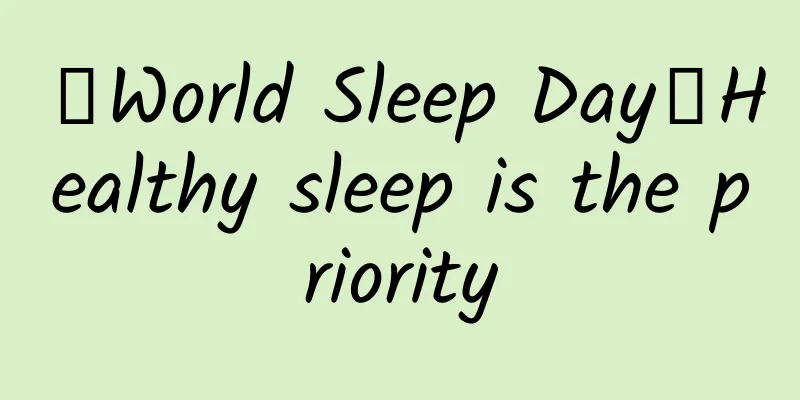【World Sleep Day】Healthy sleep is the priority

|
Written on World Sleep Day March 21 is the 25th World Sleep Day. This year's theme is "Healthy Sleep, a Priority". World Sleep Day is not only a commemorative day, but also a global event to arouse the public's attention to the importance and quality of sleep. Sleep is the cornerstone of life and the pillar of health. Good sleep can repair the body and mind, enhance immunity, and is the first line of defense against disease. However, with the accelerated pace of life, sleep disorders have become a major threat to public health. According to statistics, the global prevalence of insomnia symptoms is 20%-45%. Long-term insomnia affects the normal life and work of individuals. In severe cases, mental illness occurs. It can also lead to immune dysfunction and increase the risk of various health problems. 1. Definition of Insomnia Insomnia refers to a subjective experience in which, despite having a suitable sleep opportunity and sleeping environment, one is still dissatisfied with sleep time and/or sleep quality, which affects daytime function or causes physical discomfort. The main symptoms include: (1) difficulty falling asleep (adults have a sleep latency of more than 30 minutes); (2) difficulty maintaining sleep (awakening ≥ 2 times throughout the night); (3) early awakening (waking up 1-2 hours earlier than usual); (4) decreased sleep quality and reduced total sleep time (usually less than 6.5 hours). 2. What are the causes of insomnia? According to the latest research progress, it is speculated that insomnia may be related to the following factors. 1. Neurobiological mechanisms 1. Abnormal neural circuits Abnormal regulation of wakefulness-sleep rhythm and overactivation of the hypothalamic-pituitary-adrenal axis (HPA axis): Chronic stress leads to disruption of the circadian rhythm of cortisol secretion and inhibits the release of melatonin. fMR studies have shown that the prefrontal cortex (PFC) of insomniacs has weakened regulation of the amygdala, leading to emotional overarousal. Recent studies have suggested that it is related to thalamic-cortical-limbic system disorders. Abnormalities in the neurotransmitter system and overactivation of dual orexin receptors (OX1R/OX2R) have been shown to be associated with difficulty falling asleep. A 2017 study found that patients with primary insomnia had elevated orexin levels in the cerebrospinal fluid, leading to the maintenance of a wakeful state. 2. Inflammatory and metabolic markers Increased levels of CRP and IL-6 are positively correlated with the severity of insomnia. Long-term insomnia patients have increased levels of serum pro-inflammatory factors and abnormal mitochondrial function: Animal experiments in 2022 found that insomnia causes impaired mitochondrial autophagy in the prefrontal cortex, which can be partially reversed by supplementing coenzyme Q10. 2. Genetic factors Studies have found that the MEIS1 gene is associated with difficulty in maintaining sleep, the BTBD9 gene affects the generation of slow-wave sleep, and the methylation level of the CLOCK gene in the peripheral blood of patients with chronic insomnia is abnormal. Animal experiments in 2022 suggested that stress-induced histone acetylation changes affect the expression of sleep-related genes in the hypothalamus. 3. Psychosocial environmental factors Excessive arousal, increased sympathetic nervous system activity, decreased heart rate variability, and excessive worry about sleep can interact to aggravate insomnia. Adverse experiences in early childhood and mental stimulation can lead to chronic insomnia if not properly managed. Mental illness is also often comorbid with insomnia. Circadian rhythm disruption, caffeine/alcohol abuse, a high-sugar diet, and poor sleeping habits can all interfere with sleep. Social media use is often associated with delayed sleep onset in a dose-dependent manner. Long-term home stay and reduced exercise can also induce circadian rhythm disorders. In addition, continued activation of the vagus nerve-nucleus tractus solitarius pathway by viral inflammation after COVID-19 infection may also cause insomnia. 3. Common problems in insomnia treatment Question 1: Is medication the only way to treat insomnia? The main intervention methods for insomnia include drug therapy, psychotherapy, physical therapy and Chinese traditional medicine treatment. Drug therapy is only suitable for short-term insomnia or acute exacerbation of chronic insomnia, and must be used under the guidance of a doctor to avoid dependence and side effects. The international sleep medicine community recommends cognitive behavioral therapy as the first-line treatment for chronic insomnia. Question 2: Can I take melatonin at home if I suffer from insomnia? Melatonin is indeed an effective tool for regulating sleep rhythm and can reduce the latency period to fall asleep. The American Academy of Sleep Medicine recommends that melatonin can be used for people with circadian rhythm disorders and jet lag. It is not recommended as a routine drug for the treatment of insomnia. In Europe, melatonin sustained-release tablets are approved for the treatment of insomnia in middle-aged and elderly people over 55 years old. However, melatonin has adverse reactions such as headache, drowsiness, gastrointestinal reactions, blood pressure changes, and depression. Long-term use of melatonin can affect the secretion of endogenous melatonin. Question 3: What can people who work in shifts do to alleviate sleep deprivation? Shift workers often suffer from insufficient sleep, poor sleep quality and circadian rhythm disorders. Daytime naps are an important measure for shift workers to cope with fatigue. They are encouraged to take a 10-20 minute nap if possible. "Reserve sleep" before the shift can improve work efficiency, reduce acute fatigue, and reduce sleep latency during shift work. 4. How to self-regulate 1. Improve the bedroom environment, avoid checking the clock, avoid long daytime sleep, reduce/limit the intake of alcohol, caffeine and nicotine, and avoid overeating at dinner. 2. Avoid non-sleeping activities in the bedroom, and go to bed only when you are sleepy. For example, leave the bedroom if you cannot fall asleep for 15-20 minutes, and return to bed only when you are sleepy. 3. Lower unrealistic expectations for sleep, thinking that only sleeping 8 hours a day is a good sleep, worrying about difficulty falling asleep, and exaggerating the consequences of insomnia. 4. You can use meditation, mindfulness, and progressive muscle relaxation to limit cognitive arousal and reduce muscle tension to promote sleep. 5 By performing some opposite mental control before going to bed, that is, trying to keep yourself awake and avoid falling asleep, diverting your excessive attention from the urgency of falling asleep, you can reduce anxiety before going to bed and reduce endogenous arousal. 6. You can listen to soothing music before going to bed to reduce the excitability of the sympathetic nerves and divert attention from insomnia. Author: Chen Min, Department of Geriatrics, Beijing Longfu Hospital Image: Qianku.com Expert Profile Chen Min, deputy chief physician of the Department of Geriatrics at Beijing Longfu Hospital, has been engaged in clinical, scientific research and teaching work in the field of psychiatry and psychology for a long time. He is a member of the Health Science Popularization Working Committee of the Chinese Medical Education Association, a young member of the Psychosomatic Medicine Professional Committee of the Beijing Association of Traditional Chinese Medicine, a member of the expert database of the Beijing Mental Health Quality Control Center, and a member of the Expert Committee of the Dongcheng District Mental Health Quality Control Center. He is good at treating anxiety, depression, sleep disorders, dual heart disease, and mental disorders associated with physical diseases. He has presided over and participated in many district-level and national scientific research projects, published more than 10 papers in core journals, more than 10 medical popular science articles, and participated in the editing of two books. |
<<: Is your belly getting bigger under stress? 6 magic tricks to get rid of "stress fat" →
Recommend
Can pregnant women eat coconut chicken?
Pregnant women can certainly eat coconut chicken ...
How to deal with a sprain? You need to know these 4 points as soon as possible!
In life, we may suffer sprains due to strenuous e...
Can I eat dragon fruit during pregnancy?
During pregnancy, I always want to eat some fruit...
Is it normal for the baby to move violently at six months of pregnancy?
By the sixth month of pregnancy, the baby has gro...
Can I drink black coffee during menstruation?
There are many issues that women need to pay atte...
Who needs to have a cancer prevention physical examination?
1. Cancer prevention physical examinations are ma...
What is cervical gland cyst? Is it serious?
Cervical glandular cyst is also called cervical N...
A woman dreams of cutting her nails
Daily life includes many various trivial things, ...
How to use a belly band for normal delivery
Many mothers who have just given birth think that...
Beware! There are 4 types of "invisible alcohol" hidden in food. Be careful if you have children at home!
Everyone knows that alcohol is something that chi...
How to choose rock sugar? What are the benefits of stewing lemon with rock sugar?
The hot weather has been covering all parts of th...
Can tofu pudding enlarge breasts?
Tofu is a food that we often eat in our lives, an...
How to make small breasts bigger
Breast development is an issue that many women ar...
A complete list of slimming scented tea combinations to help you lose weight easily
Losing weight is a lifelong career for women. The...









